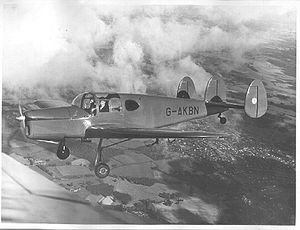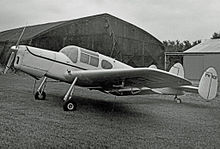- Miles Messenger
-
Messenger Miles M.38 Messenger 2A Role Liaison and private owner aircraft Manufacturer Miles Aircraft First flight 12 September 1942 Status examples still flying Primary users Royal Air Force
Private owner pilotsProduced 1942-1948 Number built 93 Developed from Miles M.28 Mercury The Miles M.38 Messenger is a British four-seat liaison and private owner aircraft built by Miles Aircraft.
Contents
Design and development
The Messenger was designed to meet a British Army requirement for a robust, slow speed, low maintenance, air observation post and liaison aircraft. The aircraft designed was a cantilever low-wing monoplane with fixed tailwheel powered by the de Havilland Gipsy Major 1D in-line engine. The prototype was converted from a Miles M.28 Mercury and first flew at Woodley on 12 September 1942. The aircraft had a good short field performance. However the Ministry of Aircraft Production had not been involved in the process and official resistance led to only a small order placed by the British Royal Air Force for the Messenger I as a VIP transport plane.[1]
Wartime users of the aircraft included Field Marshal Sir Bernard Montgomery and Marshal of the RAF Lord Tedder.
Production and operations
After the war the Messenger 2A was built for the civilian market. The production aircraft were built at Newtownards in Northern Ireland and flown to Woodley for final fitting out. After 71 aircraft were built, production of the aircraft by Miles ceased in 1948. Several examples were sold to Australia and others to Argentina, Belgium, Chile, Egypt and South Africa.[2]
During the war a prototype aircraft was built as the M.48 Messenger 3 with fully retractable electrically-operated split trailing-edge flaps and a 155 h.p. Cirrus Major III engine. This model was not further developed as it did not provide any advantage over the other variants.[3]
When the RAF retired surviving Messenger 1 aircraft in 1948 they were in good condition and most were converted for civilian use as the Messenger 4A.[4]They were flown by private pilot and business owners.
The aircraft was a popular touring and racing aircraft during the late 1940s and early 1950s. In 1954 Harold Wood in G-AKBO won the King's Cup Race air race at 133 mph.[5]
Several examples were still flying in the United Kingdom in early 2011 with private owners and flying groups.
Variants
- Messenger 1
- Military production aircraft for the Royal Air Force powered by a Gipsy Major ID, 23 built.
- Messenger 2A
- Civil production aircraft powered by the Blackburn Cirrus Major 3, 65 built.
- Messenger 2B
- Three-seat variant of the 2A powered by the Blackburn Cirrus Major 3, one built.
- Messenger 2C
- Same as the 2A but powered by the de Havilland Gipsy Major 1D, one built.
- Messenger 3
- Dual-control variant of the 2A powered by a Blackburn Cirrus Major 3, one built later re-designated the M.48.
- Messenger 4
- Same as the 2A but powered by the de Havilland Gipsy Major 10, three built.
- Messenger 4A
- Civil version powered by the de Havilland Gipsy Major 1D, one built and 19 converted from Mk I.
- Messenger 4B
- One 4A modified with a de Havilland Gipsy Major 10 engine.
- Messenger 5
- One I modified with a Blackburn Bombardier 702 engine.
- M.38A Mariner
- The prototype Messenger was fitted with an arrester hook for trials as a carrier-based anti-submarine aircraft.
Operators
- Royal Air Force
- Boston Air Transport
- Patrick-Duval Aviation
- Tyne Taxis Ltd
- Ulster Aviation
Specification (Messenger 2A)
General characteristics
- Crew: one, pilot
- Capacity: three passengers
- Length: 24 ft 0 in (7.32 m)
- Wingspan: 36 ft 2 in (11.03 m)
- Height: 7 ft 6 in (2.29 m)
- Wing area: 191 ft² (17.75 m²)
- Empty weight: 1,450 lb (659 kg)
- Max takeoff weight: 2,400 lb (1,091 kg)
- Powerplant: 1 × Blackburn Cirrus Major 3 4-cylinder air-cooled inline engine, 155 hp (116 kW)
Performance
- Maximum speed: 135 mph (219 km/h)
- Service ceiling: 16,000 ft (4,878 m)
- Rate of climb: 950 ft/min (290 m/min)
See also
- Related lists
References
Notes
Bibliography
- Amos, Peter. and Brown, Don Lambert. Miles Aircraft Since 1925, Volume 1. London: Putnam Aeronautical, 2000. ISBN 0-85177-787-0.
- Brown, Don Lambert. Miles Aircraft Since 1925. London: Putnam & Company Ltd., 1970. ISBN 0-37000-127-3.
- Jackson, A.J. British Civil Aircraft since 1919. London: Putnam & Company Ltd., 1974. ISBN 0-370-10014-X.
- Mondey, David. The Hamlyn Concise guide to British Aircraft of World War II. London: Chancellor press, 2002. ISBN 1-85152-668-4.
- Simpson, Rod, General Aviation Handbook. Midland Publishing. 2005. isbn 1-85780-222-5
Miles aircraft Southern Martlet · M.1 Satyr · M.2 Hawk · M.2 Hawk Major · M.2 Hawk Speed Six · M.2 Hawk Trainer · M.3A Falcon Major · M.3B Falcon Six · M.4 Merlin · M.5 Sparrowhawk · M.6 Hawcon · M.7 Nighthawk · M.8 Peregrine · M.9 Kestrel · M.9A Master I · M.11 Whitney Straight · M.12 Mohawk · M.13 Hobby · M.14 Magister · M.15 T.1/37 · M.16 Mentor · M.17 Monarch · M.18 · M.19 Master II · M.20 · M.24 Master Fighter · M.25 Martinet · M.26 · M.27 Master III · M.28 Mercury · M.30 X Minor · M.33 Monitor · M.35 Libellula · M.37 Martinet Trainer · M.38 Messenger · M.39 Libellula · M.50 Queen Martinet · M.52 · M.57 Aerovan · M.60 Marathon I · M.65 Gemini · M.68 Boxcar · M.69 Marathon II · M.71 Merchantman · M.75 Aries · M.76 · M.77 Sparrowjet · M.100 Student · M.105 · M.115
Lists relating to aviation General Aircraft (manufacturers) · Aircraft engines (manufacturers) · Airlines (defunct) · Airports · Civil authorities · Museums · Registration prefixes · Rotorcraft (manufacturers) · TimelineMilitary Accidents/incidents Records Categories:- Miles aircraft
- British civil utility aircraft 1940–1949
- British military utility aircraft 1940–1949
Wikimedia Foundation. 2010.



